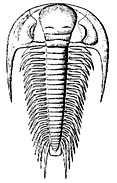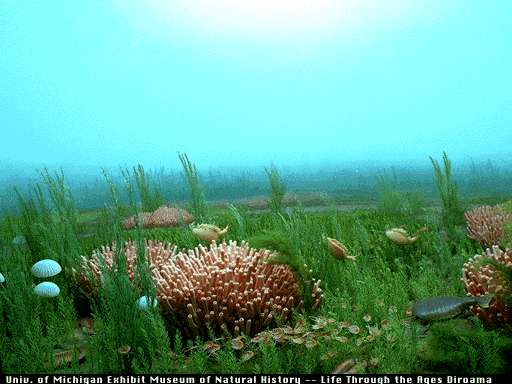
| Cambrian | ||
| Paleozoic Era | Cambrian Benthos |
| Timescale | Tommotian Biota |

Following the earliest Cambrian (Tommotian) fauna, there was a rise of herbivore grazers (e.g. gastropods), and consequent decline of algal stromatolites . There were almost no large animals, and only a few predators (chiefly anomalocaridids).
Cyanophyte algae mats encouraged mat scratchers (such as a diverse assemblage of early mollusks, previously lumped in the watebasket taxon "monoplacophora"), and some probable mat-sticking echinoderms (helioplacoids).
 Cambrian faunal guilds (original url)
Cambrian faunal guilds (original url)
Most life concentrated near sediment- water interface; with only shallow burrowers and encrusters. Even so, the Cambrian benthos had already developed a simple tiering system with two levels of (0-50 mm and 50-100 mm. The lower tier was dominated by archaeocyaths, which formed small reefs (in the Early Cambrian only: there were almost no Middle or Late Cambrian reefs), echinoderms, nonarticulate brachiopods and sponges; the higher level included archaeocyaths, echinoderms (eocrinoids and crinoids) and were rare but nevertheless included some bizarre forms such, as the helicoplacoids. , Most Cambrian echinoderms were stalked (and thus sessile), but some were motile (able to crawl about)
The Cambrian saw the beginning of bioturbators, with limited vertical mining abilities. This infauna was generally shallow, burrowing close to the sediment-water interface with the exception of vertical Skolithos burrows, which were often deep.

left - Paradoxides - a large trilobite
(length upto 45 cm)
Trilobites dominated the mobile benthos, accounting for over 50% of Cambrian hard-shelled species. They were mostly benthic epifaunal detritovores (possessing a backwards facing mouth); detritus-feeders crawling across or swimming above the sea-floor, whereas some may have lived in shallow burrows. Both body and trace fossil representatives of the trilobites are common in Cambrian strata. They are known from many growth stages, thousands of species, and trace fossils. The functional morphology of the Furongian olenids indicates the already sophisticated design of the Cambrian Trilobita.
Brachiopods included "inarticulates"; both linguates (infaunal forms with calcium phosphate shells) and craniids epifaunal forms with calcite shells). Articulate brachiopods (epifaunal with calcite shells) are present but rare
ref: Benchley and Harper, Palaeoecology, p.125
![]()